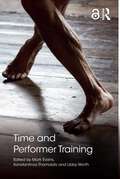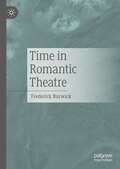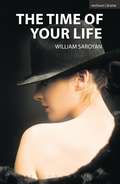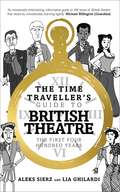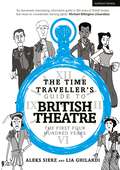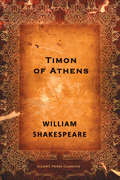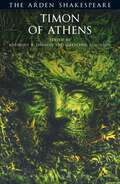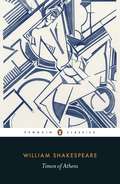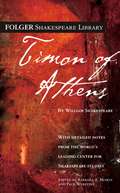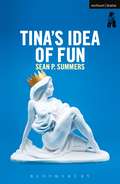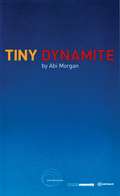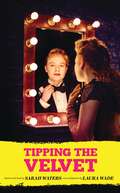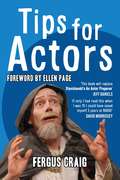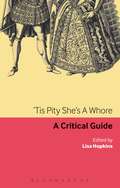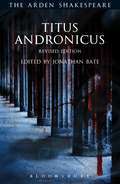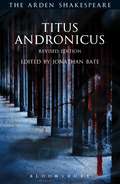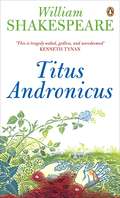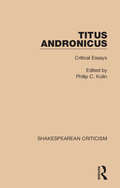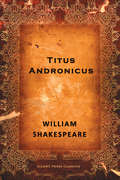- Table View
- List View
Time and Performer Training
by Mark Evans Konstantinos Thomaidis Libby WorthTime and Performer Training addresses the importance and centrality of time and temporality to the practices, processes and conceptual thinking of performer training. Notions of time are embedded in almost every aspect of performer training, and so contributors to this book look at: age/aging and children in the training context how training impacts over a lifetime the duration of training and the impact of training regimes over time concepts of timing and the ‘right’ time how time is viewed from a range of international training perspectives collectives, ensembles and fashions in training, their decay or endurance. Through focusing on time and the temporal in performer training, this book offers innovative ways of integrating research into studio practices. It also steps out beyond the more traditional places of training to open up time in relation to contested training practices that take place online, in festival spaces and in folk or amateur practices. Ideal for both instructors and students, each section of this well-illustrated book follows a thematic structure and includes full-length chapters alongside shorter provocations. Featuring contributions from an international range of authors who draw on their backgrounds as artists, scholars and teachers, Time and Performer Training is a major step in our understanding of how time affects the preparation for performance.
Time in Romantic Theatre
by Frederick BurwickThe shift in temporal modalities of Romantic Theatre was the consequence of internal as well as external developments: internally, the playwright was liberated from the old imperative of “Unity of Time” and the expectation that the events of the play must not exceed the hours of a single day; externally, the new social and cultural conformance to the time-keeping schedules of labour and business that had become more urgent with the industrial revolution. In reviewing the theatre of the Romantic era, this monograph draws attention to the ways in which theatre reflected the pervasive impact of increased temporal urgency in social and cultural behaviour. The contribution this book makes to the study of drama in the early nineteenth century is a renewed emphasis on time as a prominent element in Romantic dramaturgy, and a reappraisal of the extensive experimentation on how time functioned.
The Time of Your Life (Modern Plays)
by William SaroyanA programme text edition published in conjunction with the Finborough Theatre to coincide with the centenary of the birth of William Saroyan, The Time of Your Life runs from 26 November - 20 December. 'In the time of our life, live - so that in that wondrous time you shall not add to the misery and sorrow of the world, but shall smile to the infinite delight and mystery of it'The Time of Your Life, a rich tapestry of human life, peopled by a profusion of wistful dreamers, pining lonely hearts, and beer-hall-philosophers, is a twentieth century American masterpiece.The Time of Your Life was first presented at The Shubert Theatre, New Haven, USA, on 7 October 1939. It was the first play to win both the New York Drama Critics' Circle award and the Pulitzer Prize. . It has been revived three times on Broadway; was filmed in 1948, starring James Cagney; and twice filmed for TV. It was last seen in the UK in a star-studded Royal Shakespeare Company production in Stratford and London in 1983, and received the following review:'A remarkable play which blazes forth like a brave beacon: warming and full of fire' Daily Mail
The Time of Your Life: A Comedy In Three Acts (Modern Plays)
by William SaroyanA programme text edition published in conjunction with the Finborough Theatre to coincide with the centenary of the birth of William Saroyan, The Time of Your Life runs from 26 November - 20 December. 'In the time of our life, live - so that in that wondrous time you shall not add to the misery and sorrow of the world, but shall smile to the infinite delight and mystery of it'The Time of Your Life, a rich tapestry of human life, peopled by a profusion of wistful dreamers, pining lonely hearts, and beer-hall-philosophers, is a twentieth century American masterpiece.The Time of Your Life was first presented at The Shubert Theatre, New Haven, USA, on 7 October 1939. It was the first play to win both the New York Drama Critics' Circle award and the Pulitzer Prize. . It has been revived three times on Broadway; was filmed in 1948, starring James Cagney; and twice filmed for TV. It was last seen in the UK in a star-studded Royal Shakespeare Company production in Stratford and London in 1983, and received the following review:'A remarkable play which blazes forth like a brave beacon: warming and full of fire' Daily Mail
The Time Traveller's Guide to British Theatre: The First Four Hundred Years
by Aleks Sierz Lia GhilardiBritish theatre is booming. London’s Theatreland is an economic powerhouse and British actors are the toast of Hollywood. But where did it all start and how did we get here? To find out we time travel back four hundred years when there was not a single theatre in the land. This is where the story of British theatre starts, with the invention of new secular plays performed before large urban audiences. Beginning with the coronation of Queen Elizabeth I, Aleks Sierz and Lia Ghilardi trace the history of theatre from its lowly, lawless origins in London’s notorious Bankside, to the Festival of Britain and the accession of Queen Elizabeth II. Lively and based on extensive research, The Time Traveller’s Guide to British Theatre explores our rich and living heritage, covering all the great names — from Shakespeare to Terence Rattigan, by way of Oscar Wilde and George Bernard Shaw — and the classic plays, many of which are revived today. It visits the venues and tells their dramatic stories. At every stage of this epic journey a fictional guide — each with their own idiosyncrasies and personal prejudices — introduces our intrepid travellers to the characters, controversies, gossip, stages and plays that made four centuries of headlines.
The Time Traveller's Guide to British Theatre: The First Four Hundred Years
by Aleks Sierz Lia GhilardiBritish theatre is booming. But where do these beautiful buildings and exciting plays come from? And when did the story start? To find out we time travel back to the age of the first Queen Elizabeth in the 16th century, four hundred years ago when there was not a single theatre in the land. In the company of a series of well-characterized fictional guides, the eight chapters of the book explore how British theatre began, grew up and developed from the 1550s to the 1950s.The Time-Traveller's Guide to British Theatre tells the story of the movers and shakers, the buildings, the playwrights, the plays and the audiences that make British theatre what it is today. It covers all the great names - from Shakespeare to Terence Rattigan, by way of Oscar Wilde and George Bernard Shaw - and the classic plays, many of which are still revived today, visits the venues and tells their dramatic stories. It is an accessible, journalistic account of this subject which, while based firmly on extensive research and historical accuracy, describes five centuries of British creativity in an interesting and relevant way. It is celebratory in tone, journalistic in style and accurate in content.
Timon of Athens
by William ShakespeareWhen he loses his fortune, and he is forced to seek assistance from those he has helped in the past, Timon on Athens quickly learns who is friends are.`
Timon Of Athens: Third Series (The Arden Shakespeare Third Series)
by William ShakespeareTimon of Athens has struck many readers as rough and unpolished, perhaps even unfinished, though to others it has appeared as Shakespeare's most profound tragic allegory. Described by Coleridge as `the stillborn twin of King Lear', the play has nevertheless proved brilliantly effective in performance over the past thirty or forty years.This edition accepts and contributes to the growing scholarly consensus that the play is not Shakespeare's solo work, but is the result of his collaboration with Thomas Middleton, who wrote about a third of it. The editors offer an account of the process of collaboration and discuss the different ways that each author contributes to the play's relentless look at the corruption and greed of society. They provide, as well, detailed annotation of the text and explore the wide range of critical and theatrical interpretations that the play has engendered. Tracing both its satirical and tragic strains, their introduction presents a perspective on the play's meanings that combines careful elucidation of historical context with analysis of its relevance to modern-day society. An extensive and well-illustrated account of the play's production history generates a rich sense of how the play can speak to different historical moments in specific and rewarding ways.
Timon of Athens: A Tragedy - Primary Source Edition (Mobi Classics Series)
by William Shakespeare Nicholas WaltonAfter squandering his wealth with prodigal generosity, a rich Athenian gentleman finds himself deep in debt. Unshaken by the prospect of bankruptcy, he is certain that the friends he has helped so often will come to his aid. But when they learn his wealth is gone, he quickly finds that their promises fall away to nothing in this tragic exploration of power, greed, and loyalty betrayed.
Timon of Athens
by Paul Werstine William Shakespeare Barbara MowatThe real Timon of Athens lived there in the fifth century BCE, making him a contemporary of Socrates and Pericles. Shakespeare presents Timon as a figure who suffers such profound disillusionment that he becomes a misanthrope, or man-hater. This makes him a more interesting character than the caricature he had become to Shakespeare’s contemporaries, for whom “Timonist” was a slang term for an unsociable man. Shakespeare’s play includes the wealthy, magnificent, and extravagantly generous figure of Timon before his transformation. Timon expects that, having received as gifts all that he owned, his friends will be equally generous to him. Once his creditors clamor for repayment, Timon finds that his idealization of friendship is an illusion. He repudiates his friends, abandons Athens, and retreats to the woods. Yet his misanthropy arises from the destruction of an admirable illusion, from which his subsequent hatred can never be entirely disentangled. The authoritative edition of Timon of Athens from The Folger Shakespeare Library, the trusted and widely used Shakespeare series for students and general readers, includes: -Freshly edited text based on the best early printed version of the play -Full explanatory notes conveniently placed on pages facing the text of the play -Scene-by-scene plot summaries -A key to the play’s famous lines and phrases -An introduction to reading Shakespeare’s language -An essay by a leading Shakespeare scholar providing a modern perspective on the play -Fresh images from the Folger Shakespeare Library’s vast holdings of rare books -An annotated guide to further reading Essay by Coppélia Kahn The Folger Shakespeare Library in Washington, DC, is home to the world’s largest collection of Shakespeare’s printed works, and a magnet for Shakespeare scholars from around the globe. In addition to exhibitions open to the public throughout the year, the Folger offers a full calendar of performances and programs. For more information, visit Folger.edu.
Tina's Idea of Fun (Modern Plays)
by Sean P. SummersJust wanna be a better mother, that's all… some sort of a decent mother.Tina can't get through to her son. Stuck on the drink and tormented by her past, what will she do to get his attention? Paddy is a quiet man just looking for someone to talk to. He's a Republican, but he'll shake his fist at anything these days. When Queen Elizabeth II makes her first visit to Ireland, Tina's post-protest party brings out the worst in everyone. What lengths will people go to, to make a connection?Tina's Idea of Fun was first published to coincide with the world premiere on the Peacock stage of The Abbey Theatre, Dublin in April 2016.
Tina's Idea of Fun (Modern Plays)
by Sean P. SummersJust wanna be a better mother, that's all… some sort of a decent mother.Tina can't get through to her son. Stuck on the drink and tormented by her past, what will she do to get his attention? Paddy is a quiet man just looking for someone to talk to. He's a Republican, but he'll shake his fist at anything these days. When Queen Elizabeth II makes her first visit to Ireland, Tina's post-protest party brings out the worst in everyone. What lengths will people go to, to make a connection?Tina's Idea of Fun was first published to coincide with the world premiere on the Peacock stage of The Abbey Theatre, Dublin in April 2016.
Tiny Dynamite (Oberon Modern Plays Ser.)
by Abi MorganWhen memory takes hold, when chaos takes over and when the electricity between us becomes overwhelming. An impossible love story is given a second chance and three scorched characters are about to learn that lightning does strike twice.
Tipping the Velvet (Vmc Designer Collection #456)
by Sarah Waters Laura WadeIt’s 1887 and Nancy Astley sits in the audience at her local music hall: she doesn’t know it yet, but the next act on the bill will change her life. Tonight is the night she’ll fall in love… with the thrill of the stage and with Kitty Butler, a girl who wears trousers. Giddy with desire and hungry for experience, Nancy follows Kitty to London where unimaginable adventures await.
Tips for Actors
by Fergus Craig"In the most important theatrical book of this or any other decade, moderate twitter sensation @tips4actors (unrestrained by a 40-character limit) gives you all the advice you need to take your acting to the next level. How to upstage your fellow cast members; what to wear on the first day of rehearsals; and a guide to the finest places to poo in London's West End – it’s all in here! Who else would come up with such transformative advice as... ‘Never read the script. Would your character read the script? No, of course not. For them the script doesn’t exist.’ or... ‘When having sex with a casting director, show off your acting by faking orgasm.’? The answer is no one. Because no other writer is BRAVE enough to tell actors the truth."
'Tis Pity She's A Whore: A critical guide (Continuum Renaissance Drama Guides)
by Lisa HopkinsJohn Ford's tragedy 'Tis Pity She's A Whore was first performed between 1629 and 1633 and since then its themes of incest, love versus duty and forbidden passion have made it a widely studied and performed, if controversial, play. This guide offers students an introduction to its critical and performance history, including TV and film adaptations. It includes a keynote chapter outlining major areas of current research on the play and four new critical essays. Finally, a guide to critical, web-based and production-related resources and an annotated bibliography provide a basis for further individual research.
'Tis Pity She's A Whore: A critical guide (Continuum Renaissance Drama Guides)
by Lisa HopkinsJohn Ford's tragedy 'Tis Pity She's A Whore was first performed between 1629 and 1633 and since then its themes of incest, love versus duty and forbidden passion have made it a widely studied and performed, if controversial, play. This guide offers students an introduction to its critical and performance history, including TV and film adaptations. It includes a keynote chapter outlining major areas of current research on the play and four new critical essays. Finally, a guide to critical, web-based and production-related resources and an annotated bibliography provide a basis for further individual research.
Title and Deed (Oberon Modern Plays)
by Will EnoBehold the newest nobody of the funniest century yet. He’s almost Christ-like, from a distance, in terms of height and weight. Listen closely or drift off uncontrollably, as he speaks to you directly about the notion of home, about the notion of the world. All of it delivered with the authority that is the special province of the unsure and the un-homed, which is a word he made up accidentally. The running time, if he doesn’t die or think of anything else, is roughly one hour. Title and Deed is a provocative new work by Pulitzer Prize finalist and Horton Foote Prize winner Will Eno, whom The New York Times called ‘a Samuel Beckett for the Jon Stewart generation.’‘A haunting and often fiercely funny meditation on life as a state of permanent exile... The marvel of Mr. Eno’s voice is how naturally it combines a carefully sculptured lyricism with sly, poker-faced humor. Everyday phrases and familiar platitudes -“Don’t ever change,” “Who knows” - are turned inside out or twisted into blunt, unexpected punch lines punctuating long rhapsodic passages that leave you happily word-drunk.’ – New York Times‘The piece proves to be an always fascinating and surprisingly moving 70 minutes of theater…What emerges from his humorous, sometimes stream-of-conscious patter is a heartfelt exploration of the transience of everything in this life, from words themselves to relationships to our very existence.’ - Theatermania
Titus Andronicus: Revised Edition (The Arden Shakespeare Third Series)
by Jonathan BateTitus Andronicus is one of Shakespeare's earliest and bloodiest tragedies and was hugely successful in his lifetime. Subsequent generations have struggled with its bold confrontation of violence but in the 20th and 21st centuries the play has chimed with audiences again, perhaps because of its simultaneously shocking and playful approach to violent revenge and bodily mutilation. Jonathan Bate's original Arden edition was first published in 1995 and has had a significant influence on how the play has been performed and studied in the past 20 years. This revised edition includes a new 10,000 word introductory essay in which Bate reassess his views on the play's co-authorship with George Peele in the light of contemporary textual scholarship and updates his lively account of the play's performance history, on the international stage and screen. With detailed on-page commentary notes this will continue to be the edition of choice for students, scholars and theatre-makers.
Titus Andronicus: Revised Edition (The Arden Shakespeare Third Series)
by Jonathan BateTitus Andronicus is one of Shakespeare's earliest and bloodiest tragedies and was hugely successful in his lifetime. Subsequent generations have struggled with its bold confrontation of violence but in the 20th and 21st centuries the play has chimed with audiences again, perhaps because of its simultaneously shocking and playful approach to violent revenge and bodily mutilation. Jonathan Bate's original Arden edition was first published in 1995 and has had a significant influence on how the play has been performed and studied in the past 20 years. This revised edition includes a new 10,000 word introductory essay in which Bate reassess his views on the play's co-authorship with George Peele in the light of contemporary textual scholarship and updates his lively account of the play's performance history, on the international stage and screen. With detailed on-page commentary notes this will continue to be the edition of choice for students, scholars and theatre-makers.
Titus Andronicus: With The Trve Tragedie Of Richard The Third .
by Jacques Berthoud William ShakespeareAn embittered Roman General returns from war, having captured the Queen of the Goths and her three sons. Sacrificing the eldest, in memory of his own sons killed in battle, he provokes the queen's unending hatred. And when she is made empress by the new emperor of Rome, she quickly begins to plot a murderous revenge of barely conceivable cruelty.
Titus Andronicus: Critical Essays (Shakespearean Criticism)
by Philip C. KolinOriginally published in 1995. In three parts – introduction, criticism and reviews – this volume examines the goriest of Shakespeare’s works. The editor’s exhaustive introduction runs through the pattern of changing scholarship and commentary, introducing the key interests in the play, from its authorship to its language, rhetoric and performance. Early commentaries focused on arguing about whether the play was truly Shakespeare’s. A selection of the most important of these are included here followed by later investigations looking at myriad topics and characters – revenge, violence, race, Aaron, women, tragedy and Tamora. The large section of reviews of stage performances, arranged chronologically, ranges from 1857 to 1990. Two final pieces interestingly survey stage history of Titus in Japan and in Germany.
Titus Andronicus: Critical Essays (Shakespearean Criticism)
by Philip C. KolinOriginally published in 1995. In three parts – introduction, criticism and reviews – this volume examines the goriest of Shakespeare’s works. The editor’s exhaustive introduction runs through the pattern of changing scholarship and commentary, introducing the key interests in the play, from its authorship to its language, rhetoric and performance. Early commentaries focused on arguing about whether the play was truly Shakespeare’s. A selection of the most important of these are included here followed by later investigations looking at myriad topics and characters – revenge, violence, race, Aaron, women, tragedy and Tamora. The large section of reviews of stage performances, arranged chronologically, ranges from 1857 to 1990. Two final pieces interestingly survey stage history of Titus in Japan and in Germany.
Titus Andronicus
by William ShakespeareThe Roman general Titus is drawn into a violent cycle of revenge when he returns triumphantly to Rome with the Goth queen and her three sons as prisoners.
